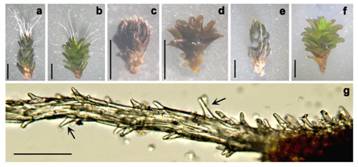Effects of Leaf Hair Points of a Desert Moss on Water Retention and Dew Formation Implications for Desiccation Tolerance
2011-12-16
In arid areas where rainfall is rare and solar radiation is strong, reducing water loss and enhancing water use efficiency are extremely important functions for plant survival. Mosses belong to a plant group that have no true roots, stems, leaves, or water transport system compared with seed plants; they are typical poikilohydric plants and it is difficult for them to control the amount of water in their tissues, and thus water is easily lost, especially from desert mosses. However, they rarely die of water loss or lack of water, as they can absorb water immediately that it is available, and rapidly recover physiological activity.
The leaf hair points (LHPs) are extended from leaf midribs, and their length varies between species. LHPs are generally white and hyaline, in some species smooth and in some spinulose. LHPs are, thus, important taxonomic characters. LHPs appear to be important exterior structures in many mosses, especially those that are desiccation-tolerant. Previous studies have been confirmed that LHPs reflect solar radiation and reduce water loss in several mosses, but whether LHPs of desert mosses have other ecological functions, such as water gain and retention, remains unclear.
Syntrichia caninervis Mitt. (Pottiaceae) is a dominant species forming biological soil crusts (BSCs) in the Gurbantunggut Desert and also found in other arid areas of central Asia and in the Mojave Desert of North America. It is important in maintaining stability in the desert ecosystem, and has gradually become a new model plant for studies of desiccation tolerance, dehydration, and recovery. S. caninervis is a typical moss with obvious leaf hair points (LHPs), but these are easily broken or fall off as a result of erosive forces (wind mainly) in the desert.
In order to examine the ecological effects of LHPs on water retention and dew formation at individual and population (patch) levels, researchers from Xinjiang Institute of Ecology and Geography chose the Syntrichia caninervis as an example to study the ecological effects. The results showed that although LHPs were only 4.77% of shoot weight, they were able to increase absolute water content (AWC) by 24.87%. The AWC of samples with LHPs was always greater than for those without LHPs during dehydration. The accumulative evaporation ratio (AER) showed an opposite trend. AWC, evaporation ratio and AER of shoots with LHPs took 20 min longer to reach a completely dehydrated state than shoots without LHPs. At the population level, dew formation on moss crusts with LHPs was faster than on crusts without LHPs, and the former had higher daily and total dew amounts. LHPs were able to improve dew amounts on crusts by 10.26%. Following three simulated rainfall events (1, 3 and 6 mm), AERs from crusts with LHPs were always lower than from crusts without LHPs. LHPs can therefore significantly delay and reduce evaporation. This study confirms that LHPs are important desiccation-tolerant features of S. caninervis at both individual and population levels. LHPs greatly aid moss crusts in adapting to arid conditions.
Financial assistance was provided by the Key Knowledge Innovation Project of the Chinese Academy of Sciences, the National Basic Research Program, the National Natural Science Foundation of China, and the West Light Foundation of the Chinese Academy of Sciences.
The results of this work were published on Journal of Plant Research, 2011 (http://www.springerlink.com/content/r95t24572g507264/).

Morphology of S. caninervis shoots and leaf hair points (LHPs) under dehydrated and hydrated conditions. a Natural shoots with LHPs under dehydration. b Natural shoots with LHPs under hydration. c Natural shoots without LHPs under dehydration. d Natural shoots without LHPs under hydration. e Shoots with LHPs manually removed under dehydration. f Shoots with LHPs manually removed under hydration. g The middle and base of one hydrated LHP. Arrows show spinules on the surfaces of the LHP and midrib. Scale bars 1 mm in a–f; 50 μm in g



